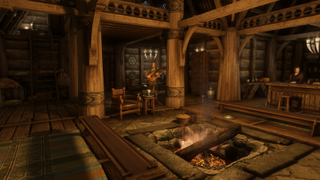Auto-installing over 600 mods makes Skyrim beautiful and confusing
Thanks to Wabbajack, it's easy to make Skyrim almost unrecognisable—for better or for worse.

Last month I reinstalled Skyrim—for work, you understand. Almost despite myself, I soon felt the urge to replay it; to once again get lost in the comforting expanse of snowswept fantasy. That naturally led to another realisation: I should mod this. Obviously I'd already installed SkyUI, because Skyrim is basically unplayable without it. But no, I should really mod this. And, crucially this time, actually play it once I have.
There's a kind of separate game that exists above Skyrim that doesn't really involve interacting with Skyrim at all. I have played it many times. Here are the rules:
- You research the best Skyrim mods.
- You ignore most of that research, sort Nexus Mods by most downloaded, and pick whatever isn't some creepy, inexplicably popular Lydia mod.
- You download them, after a cursory check into whether there'll be any conflicts.
- You run LOOT in lieu of taking the time to learn how load order works, and hope that it proves an effective substitute for knowing what you're doing.
- You create a character. This is it! You're playing modded Skyrim!
- A couple of hours later you're distracted by something else—perhaps some other RPG you left half-finished before you started this project.
- It is months—maybe years—later. You're between games, and, browsing through your Steam list, you remember all the hours you spent modding Skyrim all that time ago. Maybe now's the time to finally play it, you think. But, you realise, you're a different person now. Older, wiser. Your tastes have changed. If you're going to do this, you should start from the beginning—see what the community has made since the last time you looked.
- Return to step one.

Skyrim mods: Questing forever
Skyrim Special Edition mods: Special effects
Skyrim console commands: Endless possibilities
This time, though, I was going to do it properly. A while ago, I discovered a couple of mod guides—exhaustive projects, often containing hundreds of mods, painstakingly chosen to tweak Skyrim in very specific ways. I'm a big fan of letting other people do the hard work for me, so this seemed like the perfect way to make Skyrim feel fresh.
Or at least, it did until I started reading one. Even with a step-by-step guide, the sheer effort of installing and configuring it all seemed monumental. Luckily, one of the guides referenced a tool called Wabbajack. Suddenly, an absurdly modded Skyrim was in reach.
Wabbajack is a program that automates the installation of these mega-guides. You run it. You tell it where all your directories are. You pick one of its supported lists. And then you go to sleep. That's it.
When you wake up, you have hundreds of Skyrim mods ready to go. Well, almost ready. There are still some steps you need to manually perform, especially if the guide you've picked recommends an ENB wrapper. Even if it doesn't, you've got to manually configure the mods in-game. Nevertheless, it's a lot easier to configure a handful of mods than to install hundreds.
The first list I picked was based on Lexy's Legacy of the Dragonborn—a guide built around the Legacy of the Dragonborn mod. The mod itself sounds like an impressive piece of work, billing itself as an expansion-sized addition that adds new items, new quests and, most importantly, a display hall for showing off artifacts and a new explorer's guild. And to that, Lexy's list adds even more stuff, all curated to support what Legacy of the Dragonborn does. New quests! New systems! New locations! New armour! Werebears! It sounded like a definitive round-up of the modding community's most audacious creations, which instantly piqued my interest.
The biggest gaming news, reviews and hardware deals
Keep up to date with the most important stories and the best deals, as picked by the PC Gamer team.

Within minutes of playing, though, I realised I'd made a mistake—one that, to be clear, was entirely of my own making. It's not just that the thought of installing hundreds of mods made me tired, I also didn't really fancy reading and remembering which mods were being installed. "It'll be an adventure!" I declared as I decided to jump in completely blind. Suddenly, I was freezing to death in Windhelm, penniless and without the resources to craft warmer armour. Things kept happening, and I rarely understood why. And, thanks to an extensive series of combat and difficulty tweaks, every fight was a brutal battle for survival.
Things kept happening, and I rarely understood why.
And sure, I could have fought through the confusion. But already I knew I was out of my depth. This is a mod list designed for those bored of Skyrim, who want to break it into something weird and deadly. But it's been many years since I last played, and I was quite looking forward to the comforting blanket of nostalgia. I needed a list that was still essentially Skyrim. Just better.
I returned to a fresh install, and tried again, this time with something a little more familiar. The Phoenix Flavour is an expertly written guide—clear, easy to follow, and with a careful aim to mostly preserve the vanilla experience. Rather than picking mods that outright replace existing systems, it focuses instead on improving and overhauling. Obviously there's a swathe of graphical enhancements, but it also features mods that touch nearly every aspect of the game's systems.

I still wasn't going to do the work myself. Once again I turned to the unofficial list on Wabbajack, and let it take care of downloading, configuring and installing the 606 mods the guide uses. The result is exactly what I wanted—familiar, but just different enough to keep me on my toes. In the witch's house outside of Bleak Falls Barrow, I discover a note that I don't remember ever seeing before. It feels like a new mod quest, but I can't be sure. It's been a while since I last played Skyrim—maybe I just missed it before? Crucially, these moments are rare, and intriguing when they do occur.
Obviously the whole thing looks great, but there's also a reassurance in playing something so meticulously crafted. There's a lot about vanilla Skyrim—even the Special Edition version that I'm playing for the first time—that feels rough; like everything is liable to break at any moment. Logically I know that's even more true of such a heavily modded version, but it feels like I'm in safe hands. There are over 600 mods here, and I know what maybe a handful of them actually do. The effect is I get to assume that one of them has already fixed a quest step that was bugged, or addressed a system that never quite worked as intended—at least until I come across some inexplicably dancing honey nut treats.
It's also still recognisably a product of many different, disparate mods, leading to a few tonal inconsistencies. The female NPCs all look like Instagram models—this is pretty much standard for Skyrim mods—and, in one recent loading screen tooltip, the game informed me that "Your children are safe with me... MUWAHAHAHA".
Sure, it would be better if I'd taken the time to figure it out myself—specifically tailoring the experience to my preference. But also I know myself. I'd have spent more time looking out for conflicts and errors and things I'd done wrong than actually playing the game. Instead, I'm just enjoying Skyrim, being delighted by the many small changes and the incredible tree textures, but also being thankful for all the ways it's still the same.

Phil has been writing for PC Gamer for nearly a decade, starting out as a freelance writer covering everything from free games to MMOs. He eventually joined full-time as a news writer, before moving to the magazine to review immersive sims, RPGs and Hitman games. Now he leads PC Gamer's UK team, but still sometimes finds the time to write about his ongoing obsessions with Destiny 2, GTA Online and Apex Legends. When he's not levelling up battle passes, he's checking out the latest tactics game or dipping back into Guild Wars 2. He's largely responsible for the whole Tub Geralt thing, but still isn't sorry.
Most Popular



